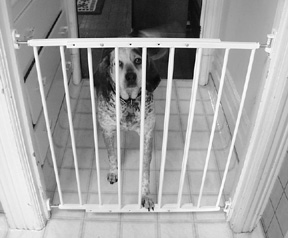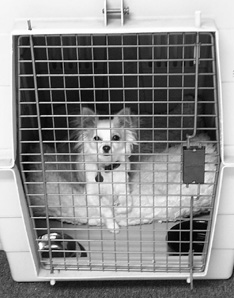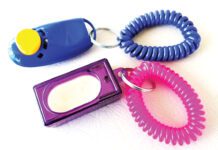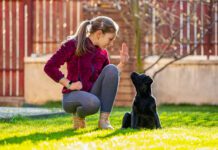[Updated July 6, 2018]
HOUSE TRAINING ADULT DOGS: OVERVIEW
1. Start with a thorough veterinary examination, to make sure your dog does not have a medical excuse for her incontinence.
2. Invest in a large enough crate, X-pen, or baby gates to confine your dog to a safe zone when she is not being supervised.
3. Don’t let your “supervision” get lax. No exceptions.
4. On a regular schedule, take your dog to the area where you want her to eliminate. When she goes, praise and reward her copiously.
5. Do not punish your dog for “accidents.” No exceptions.
Meet “Mollie,” a three-and-a-half-year-old terrier who lives in Aptos, California. (Her name has been changed to protect the guilty!) Mollie is a great dog, except for one not-so-small issue: Mollie is not housetrained. She does not know when or where she is supposed to go. Left to her own devices, Mollie would eliminate in the living room, the bedroom, on top of a pile of clean laundry, and, yes, even in her own crate.
Mollie’s housetraining issues, however extreme, are easily explained. The first several years of Mollie’s life were spent in a poorly run breeding kennel. She was not only never formally housetrained, but also forced to urinate and defecate regularly in her living space. In addition, Mollie also developed an infection that made it impossible for her to hold it, even when she was crated.

By the time she came to live in her current home, her lack of inhibition was cemented, and housetraining has been her number one problem behavior.
Mollie is not a bad dog; in all other ways she is a wonderful companion! And she is not alone in her problem; many adult dogs are not fully housetrained. Fortunately, there is hope for Mollie and other dogs like her. Adult dogs, even dogs whose histories have stacked the odds against them, can learn an appropriate place and time to go!
Understanding House Training Problems
Of course, not all dogs with housetraining problems come from kennels or shelters. Adult dogs can have a variety of explanations for their housetraining failures. Even dogs who have been in stable homes since puppyhood can have trouble with housetraining.
Some of the most common reasons that dogs fail to learn when and where to eliminate include:
• Having a medical problem. If you have a dog that was reliably housetrained and suddenly has housetraining problems, consider the possibility of a medical issue. Infections, certain illnesses, and some medications can all contribute to house-soiling.
• Not truly understanding the “house” rules. For example, a dog may understand that he needs to go outside and will do so when he has free access (such as a doggy door), but not understand that he needs to hold it when he does not have free access.
• Not having generalized the rules from one place to another. A dog may have been house-trained in a previous home, but not know the same rules apply in a new home. Or, a dog may know to go outside at his house, but not understand that he also needs to go outside when visiting a friend’s house or staying in a hotel.
• Being asked to “hold it” for too long. Some dogs can easily go all day without eliminating. For other dogs, holding it all day is very difficult or even impossible. This can be especially true for dogs who are small, young, elderly, or who have a medical problem.
• Having learned that eliminating in their living space is acceptable.Like Mollie, dogs that have spent much of their lives in kennels often lose their natural inhibition about eliminating where they eat and sleep. In addition, dogs with a history of “accidents” in the home because of an illness, poor management, or other factors may simply learn that it is less stressful to go inside than to try to “hold it.”
Is It a Housetraining Problem? Or Something Else?
When talking about housetraining for adult dogs, it’s important to understand that not all house soiling is a housetraining problem. Other physical and behavior issues can contribute to or cause a dog to eliminate in the house. If you suspect your dog may have any of these issues, please consult with a behavior counselor or qualified trainer.
Submissive or excitement urination. Dogs who leak urine during greetings, when meeting new people, when you first come home, or during play may be exhibiting submissive or excitement urination. This is a confidence issue (and is often outgrown as a young dog matures), not a housetraining issue!
Marking. When we think about territory marking, most of us think only about male dogs. But male and female dogs can mark territory with both urine and feces, outside and indoors.
Separation anxiety. Dogs suffering from separation anxiety may eliminate shortly after you leave your home, often within just a few minutes. (If you are not sure the accidents are happening shortly after you leave, try returning home after a half hour to find out.) Consult with a behavior professional to help you resolve your dog’s separation anxiety.
Fears and phobias. Thunderstorms, fireworks, and other fear-inducing noises can cause some dogs to urinate or defecate in the home.
Health issues. Any onset of house-soiling behavior in a previously housetrained dog, urination during sleep, or other loss of bladder and bowel control should be evaluated by a veterinarian. Urinary tract infections, certain illnesses, and some medications can contribute to house-soiling problems.
How to Teach Your Dog Where to “Go”
Housetraining is not a single behavior. Rather, it is a whole series of interrelated behaviors.
For a dog to be fully housetrained, he needs to understand where he should go as well as where he shouldn’t. He needs to learn to “hold it” (sometimes for hours) until he is in an appropriate place. He needs to be able to communicate his need to go in a way his people will understand and respond expediently. And he needs to generalize these behaviors to all indoor (and some outdoor) situations. For any adult dog with a history of housetraining issues, it can also mean unlearning past behaviors.
If this sounds like a lot of learning on your dog’s part (as well as training on your part), don’t despair. These simple steps can help you teach your dog the skills he needs to become a full-fledged, housetrained dog.
First, supervise your dog at all times when he is inside, except when he is crated or otherwise confined. This is the key to success. You must supervise your dog inside your home at all times to prevent accidents. The more consistent you can be, the faster your dog will succeed.
Note that in this case, “supervise” means much more than having your dog with you in the same room. It means keeping your attention focused on the dog so as to prevent any opportunity for the dog to make a mistake, or, at the very least, to be able to interrupt him “midstream” – a good opportunity to rush him outside and then praise him for going in the “right” place (more on this below).
The best way to accomplish this when you are not actually looking at the dog or playing with him, is often referred to as the “umbilical cord” method. If you are watching TV, working on your computer, washing dishes, or otherwise occupied, clip a leash onto your dog’s collar, and tie the other end around your waist or belt loop. It should be long enough to allow him to sit or lay at your feet, but short enough to prevent him from making a move to eliminate without your knowledge.
When you are neither actively watching your dog nor physically linked to him by a short leash, he should be confined, as described below.
Properly Confining Your Dog for House Training
• Confine your dog when you can’t supervise him. When you cannot actively supervise your dog, leave him confined in a crate, X-pen, or other small secure space. Because dogs are not as likely to soil where they eat or sleep, a sleeping area like a crate is ideal.
• If your dog regularly eliminates in his crate or other confined space, and your veterinarian has ruled out all health problems as the cause, try changing your confinement area. If you have been using a crate, for example, change to an X-pen in a different part of the house. Start by feeding your dog in her new confinement space and leaving her alone there for only short periods.
If your dog has been eliminating on her bedding, change the type of bedding you use, too. If she’s been sleeping (and eliminating!) on a blanket, switch to a flat thick bed of newspaper, or a fleece pad. The idea is to create a new “living space” with no former associations for your dog as a place to eliminate. Continue to use the crate as a living space for longer periods until you have established the new confinement area as a living space.
• Set up a routine. You’ve probably heard this before: what goes in on schedule, comes out on schedule. Establish regular feeding, sleeping, and waking times. Take your dog out, at minimum, upon waking, after eating and drinking, before leaving home, immediately after play, when you first arrive home, and before bedtime.
• Teach your dog where to go! This is an important and often overlooked step. Pick a spot that you regularly take your dog to; don’t just put him outside, go with him. When your dog goes in the appropriate spot, immediately reward the behavior with praise and a treat. A dog who is rewarded for going in a specific spot will be more motivated to go in that place and may also begin asking to go to the place (offering the behavior!) because it earns rewards.

• Read your dog’s signals. Look for clues in his behavior that tell you he needs to go outside. Dogs won’t always go to the back door. Some common signs include acting restless, “bugging” you, pacing, and just before the act, circling. But sometimes the behavior is more obscure, so be observant. (One of my dogs licked the cat’s ears when she needed to go outside – a behavior I assume she learned because we always paid attention to her when she paid attention to the cat.)
In addition, try to anticipate your dog’s needs. Does he always need to go outside immediately after waking? When someone comes to the door? After playing?
• When accidents happen, don’t punish! If you actually catch your dog in the act – and I mean midstream, not one second after – it’s okay to interrupt with a clap or noise and then rush the dog outside. Be sure to reward your dog when he finishes up outside. If you discover the act afterward, even immediately afterward, don’t punish your dog. It really won’t help, and could set back the process by making your dog afraid to go in front of you. Simply clean up the accident well with an enzyme neutralizing cleaner. (See “Housetraining Puppies” for a review of the best enzyme-based cleaning agents.)
• Gradually expand the “safe” zone. Once you have established a routine wherein your dog is supervised or confined, goes outside on a schedule, and avoids accidents for a month or longer, begin cautiously increasing your dog’s freedom. For example, if your dog’s confined space is a small X-pen in the kitchen, you might begin by expanding the size of the pen. Once he proves himself reliable in the slightly larger space, leave him confined to the kitchen.
Gradually increase his space until he is reliable within your entire home. If problems arise (remember that mistakes are part of the learning process), simply back up to the last reliable step and take it slower. Taking it too slowly is much better than rushing the process, especially with a dog that has a history of housetraining issues.
Patience Pays Off
The most frequent question I have been asked about house-training an adult dog (and puppies, too) is, “How long will it take?” The answer is, “It depends.” It depends on the dog, the situation, and you. There is no magic formula or specific amount of time.
I have noticed that often people want it to take a lot less time than is realistic. (I think we’ve all heard stories of the dog that was housetrained in a week and wish that could be our dog.) Think about all of the steps the dog needs to learn – to go in a specific place, to hold it for a period of time, to ask when he needs to go out, to apply these rules to all inside areas. Be patient! This is a lot for a dog to learn. Plan on a few months at minimum, and a year or more for a dog with a longer history of housetraining issues.
Of course, that doesn’t mean you have to deal with your dog actually eliminating in the house for months! Remember the first two steps: supervise and confine. With diligence, you can establish a routine that will help you avoid most accidents within a few weeks, if not sooner.
Remember Mollie? After a few short months, Mollie was 100 percent reliable in her X-pen (remember, this is a dog who would eliminate in her crate!) and when supervised by her people. She’s still not ready to be left unsupervised (and with her history, it may take longer than most for her to be ready), but Mollie is certainly well on her way to becoming fully housetrained. Patience does pay off!
Mardi Richmond is a writer and trainer who lives in Santa Cruz, California, with two wonderful dogs and one human partner. She is the coauthor of Ruffing It: The Complete Guide to Camping with Dogs.







I have a three year old Staffie who I got from a shelter. Ive had him for about two years. I moved about a year and a half ago and he slowly started losing all his house training. It’s gotten so bad he won’t even go outside anymore and holds it until he has an opportunity to go inside. I don’t know what to do anymore. I’ve tried everything. Its been a year and a half of back and forth and now it’s worse than ever
My new rescue dog is about 6 years old and she’s a trooper – only going outside when we walk. The problem is that she won’t go in our yard, even when we didn’t go for a walk for 2 days!
I’ve put some of her poop in the yard but she avoids it – it could be this was forbidden in a previous home.
Suggestion?